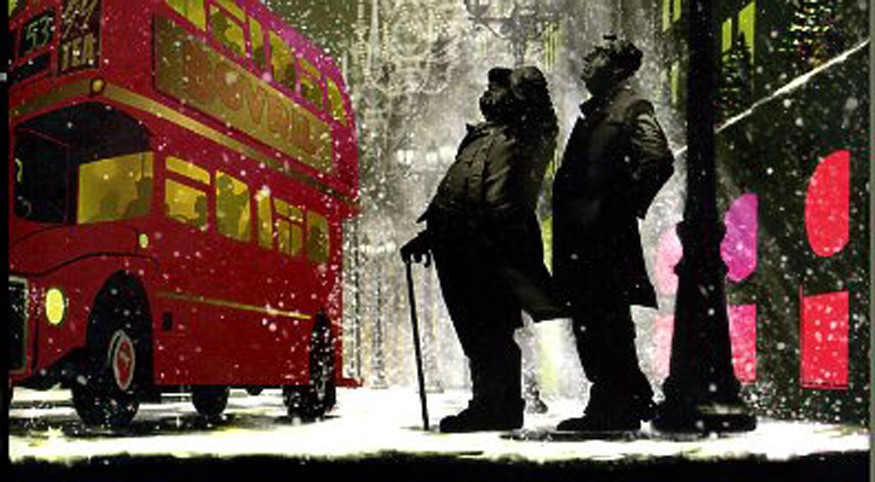 Arthur Bryant and John May are elderly London detectives who work for The Peculiar Crimes Unit – a branch of London’s Metropolitan Police. The creation of English crime author Christopher Fowler, they tackle cases that are too obscure, quirky and downright complex for regular Scotland Yard officers to solve. The series began with Full Dark House in 2003 and is shot through with literary references, an encyclopaedic knowledge of the highways and byways of London, and an acute sense of English popular culture.
Arthur Bryant and John May are elderly London detectives who work for The Peculiar Crimes Unit – a branch of London’s Metropolitan Police. The creation of English crime author Christopher Fowler, they tackle cases that are too obscure, quirky and downright complex for regular Scotland Yard officers to solve. The series began with Full Dark House in 2003 and is shot through with literary references, an encyclopaedic knowledge of the highways and byways of London, and an acute sense of English popular culture.
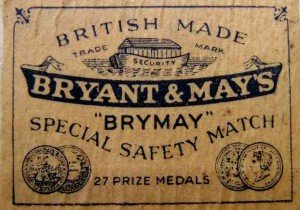 There are many jokes in the books, but let’s get the main gag out of the way first – the detectives’ names. Readers of a certain age will be all too familiar with how Bryant and May came to light up their lives – literally. The celebrated brand of matches were made at a factory in Bow, East London, for generations. The name has survived, but like so much else, the product is now made overseas.
There are many jokes in the books, but let’s get the main gag out of the way first – the detectives’ names. Readers of a certain age will be all too familiar with how Bryant and May came to light up their lives – literally. The celebrated brand of matches were made at a factory in Bow, East London, for generations. The name has survived, but like so much else, the product is now made overseas.
Like all the best fictional detective partnerships, Bryant & May are like chalk and cheese on the one hand, but can be more like port and Stilton when occasion demands. John May is the ‘normal’ one. He has a family, albeit one with problems, enjoys female company, dresses well, and knows how and when to deal with people of lesser ability who just happen to be the boss. If any physical exertion is required, he’s the one with some semblance of a physical presence. Arthur Bryant is older than his friend, unkempt, shambolic in his personal habits, dangerously forgetful, but with a mind like a scalpel. He is frequently rude and abrasive, but has an arcane knowledge of the world and its doings that would overload any database yet constructed. He masks this erudition by behaving like an octogenarian schoolboy. Turning out his overcoat pockets is likely to reveal a conker on a string, a 1949 tram ticket or the remains of a bag of sherbet lemons.
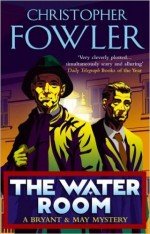 In the heart of London
In the heart of London
There are several ever-present themes in the stories. One is an acute awareness of the hidden topography of London. In The Water Room (2004), the plot hinges on the fact that beneath the streets of London there are a myriad of buried streams and rivers which once bisected the capital above ground. (Ben Aaronovitch used a similar theme in Rivers of London seven years later.) The city’s abundance of largely Victorian theatres comes to the fore in Full Dark House and The Memory of Blood (2012).
While buildings take on a life of their own, human beings – real and fictional – exert an influence. In Ten-second Staircase (2006) the spectre of an infamous highwayman haunts the narrative, and in On the Loose (2010), a horrific antler-wearing apparition reminiscent of the legendary Herne the Hunter terrorises developers and builders in Fowler’s own backyard, the King’s Cross district.
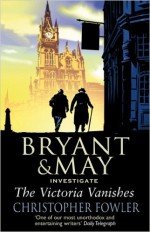 Fowler is a very erudite chronicler of British popular entertainment from days gone by. He loves the element of mechanical illusion which was the mainstay of theatre and film before the days of CGI. One of his more audacious tales is The Victoria Vanishes (2009). Not only have all the human witnesses to a woman’s murder disappeared, but so has the pub outside which her body was found. Resolving this little difficulty would tax the inventive powers of many an author, but Fowler does it with just a wave of his conjuror’s wand, and a sprinkling of magic dust.
Fowler is a very erudite chronicler of British popular entertainment from days gone by. He loves the element of mechanical illusion which was the mainstay of theatre and film before the days of CGI. One of his more audacious tales is The Victoria Vanishes (2009). Not only have all the human witnesses to a woman’s murder disappeared, but so has the pub outside which her body was found. Resolving this little difficulty would tax the inventive powers of many an author, but Fowler does it with just a wave of his conjuror’s wand, and a sprinkling of magic dust.
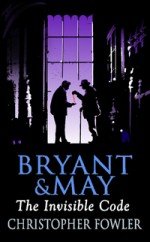 Call the police…
Call the police…
It should not be thought that the eccentric pair plough their lonely furrow under the benevolent gaze of their professional and political bosses. The regular police and, more crucially, the inhabitants of those dark, satanic towers at The Home Office, despise Bryant and May with a vengeance. The senior citizens had no more implacable enemy than the saturnine Oscar Kasavian who, despite his name, was a senior man in that department. When his exotic Albanian wife shows all the signs of becoming unhinged, the acerbic civil servant swallows his pride and calls in Bryant and May to investigate in The Invisible Code (2012). You can read our review.
Every good series needs its walk-on parts, and there is a vibrant cast of others who populate the novels. We have the voluptuous bottle-blonde 1950s starlet, otherwise known as DS Janice Longbright. To my eternal shame, whenever Janice appears, I cannot get rid of the image of Mandy, Dick Emery’s immortal drag persona. Raymond Land is the Acting Temporary Chief of the PCU, and is one of life’s Great Administrators. By their paperclips ye shall know them – and Land recoils in horror at the ramshackle ways of his senior detectives. Fowler has a way with names, rather like Dickens and Hardy, and Arthur’s long-suffering Antiguan landlady, Alma Sorrowbridge, couldn’t have been better named by either of those literary giants.
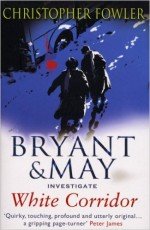 Coming full circle
Coming full circle
Arthur and John rarely stray beyond the M25 motorway that circles the city, and Arthur in particular becomes more ill at ease the further he travels from Waterloo Bridge. However, in White Corridor (2008) our men are stranded in a West Country snowdrift while, back at home, a PCU officer has been killed. Two hundred miles of snowbound road and a dire mobile phone signal notwithstanding, the two elderly gents manage to outwit a ruthless killer as well as wrap up the PCU murder. We have reviewed The Bleeding Heart (2014) and The Burning Man (2015). The most recent Bryant and May book is London’s Glory and instead of being a novel it’s filled with short stories. We’ve reviewed that too.
 Don’t make the mistake of thinking that these novels are on the cosy side. Despite the artful plotting, the nostalgic view of an England we have lost, the in-jokes, and the warmth Fowler shares with anyone who loves London, there is dark side. Death is a frequent caller, and when we answer the door, he is not draped in a discreet undertaker’s sheet, but is red in tooth and claw. Christopher Fowler is unique in contemporary English fiction. He blends Golden Age crime with the poetic insights of John Betjeman, the gimlet eye of Charles Dickens and Peter Ackroyd’s dark nostalgia.
Don’t make the mistake of thinking that these novels are on the cosy side. Despite the artful plotting, the nostalgic view of an England we have lost, the in-jokes, and the warmth Fowler shares with anyone who loves London, there is dark side. Death is a frequent caller, and when we answer the door, he is not draped in a discreet undertaker’s sheet, but is red in tooth and claw. Christopher Fowler is unique in contemporary English fiction. He blends Golden Age crime with the poetic insights of John Betjeman, the gimlet eye of Charles Dickens and Peter Ackroyd’s dark nostalgia.
Christopher Fowler spoke to us earlier in 2015 in this interview.The next in the series will be Strange Tide, the 13th book, released in March 2016.








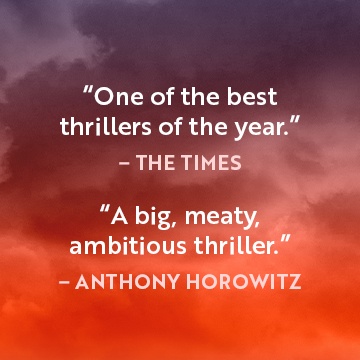
Thank you for your very kind and rather perspicacious words on the old codgers – I honestly never thought readers would take to them as they have. It’s very inspiring and requires me to keep digging deeper into weird London! A very merry Christmas to you…
I absolute love the Bryant & May stories and have bought every one in hardback. Last night at 2am I finished ‘The Burning Man’ having read the last 280 pages in a sitting. How are you going to deal with Arthur’s failing memory I wonder?
I have two points though, one very minor. I have noticed the misspelling of ‘minuscule’ on two separate occasions (ie different books) It is shown as miniscule in both cases. Sorry for being so pedantic!
The second is the lack of continuity in the ages of John and Arthur. In Full Dark House they were young detectives in the Blitz (say 1940). So they could have been born at the latest in 1920. Then in a later book Arthur talks about his young teenage years in the 1950s. I can’t recall if you gave an explanation of this somewhere; I assume it is really so you can still set the books in the present yet have the detectives still old but plausibly capable of doing their detecting. Please keep them coming!
The other thing is that you use some seriously obscure and erudite vocabulary which has me reaching for the dictionary several times per book. I wonder if this in keeping with Arthur’s erudition or are you just having a bit of fun with the language?
will be getting one..most likely the first..i like that style of novel..thanx for the article
I’m another fan…..have read them all, and now in bed with a bad back, am rereading them all.
However, one disturbs me a little. While Burning Man is a good story, parts of it, commentary about various characters and some character responses, do not ring quite true, and I wondered if, perhaps, parts of this one were ‘farmed out’, a practice not unheard of.
I am extremely fond of Mr Fowler’s books for so many reasons, not least among them that
‘ the funny bits ‘ still make me laugh, as in L.O.L., on the third or even fourth reading.
Not to be read in public – your reaction can be a little disturbing to any stranger in the same railway carriage or wherever.